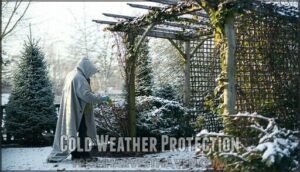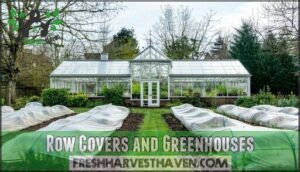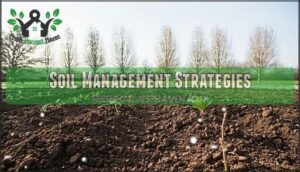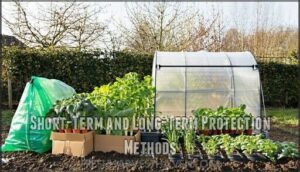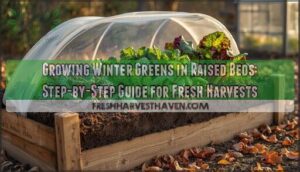This site is supported by our readers. We may earn a commission, at no cost to you, if you purchase through links.
 Cold weather crop protection methods safeguard your plants from frost damage and winter stress through proven techniques.
Cold weather crop protection methods safeguard your plants from frost damage and winter stress through proven techniques.
You’ll want to apply mulch around plant bases for soil insulation, install row covers or frost blankets for temperature protection, and create windbreaks to reduce cold air exposure.
Water your crops before expected frost events – the ice formation actually releases heat that protects plant tissues.
Choose cold-hardy varieties suited to your climate zone, and time your planting to avoid the worst cold snaps.
Proper soil drainage prevents root freeze damage, while greenhouse structures offer complete environmental control.
These fundamental strategies form the backbone of successful winter gardening, but mastering the timing and combinations creates truly bulletproof protection, using methods like row covers and ensuring proper soil drainage to prevent damage.
Table Of Contents
- Key Takeaways
- Frost Damage Risks
- Cold Weather Protection
- Protective Measures
- Soil Management Strategies
- Effective Frost Protection
- Frequently Asked Questions (FAQs)
- How do farmers maintain crops in cold weather?
- What is the best thing to cover plants from cold weather?
- How do farmers protect crops from frost?
- How to protect crops from extreme weather?
- How do farmers protect their crops from cold weather?
- What are the best ways to protect plants from cold?
- What are the three types of frost protection?
- What temperature is too cold for crops?
- How does frost protection affect plant diseases?
- Can companion planting improve frost tolerance?
- Conclusion
Key Takeaways
- Layer multiple protection methods – combine row covers with mulching and windbreaks for maximum effectiveness rather than relying on a single approach.
- Time your interventions correctly – apply protective measures when temperatures approach 32°F, not after damage occurs, and water soil before expected frost events.
- Select hardy varieties and ensure proper drainage – choose cold-resistant plants suited to your climate zone and improve soil drainage to prevent root freeze damage.
- Create strategic microclimates – position plants near heat-retaining surfaces like walls, use raised beds for better drainage, and apply 3-4 inches of mulch for soil insulation.
Frost Damage Risks
When winter arrives, your crops face three major threats that can destroy months of hard work.
Frost damage occurs when ice crystals form inside plant cells, causing them to burst and leading to wilting, while cold winds strip moisture from leaves, creating brown patches that weaken your plants over time, due to frost damage.
Cell Damage and Wilting
When temperatures drop below freezing, water inside plant cells expands and causes cellular rupture.
This frost damage disrupts photosynthesis and creates plant dehydration, leading to stunted growth.
You’ll notice wilting leaves and blackened stems as plant tissue damage becomes visible.
Think of it as your plants getting frostbite – their cell walls burst from freezing mechanisms, requiring immediate frost protection methods.
Moisture Loss and Browning
Cold winds steal moisture from your plants faster than you’d expect, creating Winter Desiccation that turns healthy crops brown and brittle. Evergreen Damage becomes especially severe when frozen plants can’t replace lost water through their roots.
- Windbreak Effects reduce moisture loss by blocking harsh winter winds
- Mulch Hydration maintains soil moisture levels around vulnerable root systems
- Watering Strategies should focus on deep soaking before freezes hit
- Winter mulch creates protective barriers that prevent rapid moisture evaporation
Soil Erosion and Nutrient Depletion
Winter rainfall creates a perfect storm for soil erosion and nutrient depletion in your garden.
Heavy downpours wash away topsoil and essential nutrients, leaving your plants vulnerable come spring.
You’ll need erosion control measures like straw mulch garden coverage or leaf mulch benefits to protect soil composition.
Organic matter additions help combat nutrient loss while improving drainage.
Apply mulch for winter protection around plant bases—this simple step prevents erosion and maintains soil structure.
Your proactive approach to managing winter rainfall impacts will reward you with healthier, more resilient crops next growing season.
Cold Weather Protection
You’ll achieve the best frost protection by selecting plant varieties that naturally resist cold temperatures and can withstand your local winter conditions.
Proper timing of protective measures like covering plants and strategic pruning helps maximize their survival during harsh weather periods, which is crucial for frost protection.
Choosing Hardy Plant Varieties
Building your winter garden’s foundation starts with genetic diversity from breeding programs that’ve developed frost tolerant plants over generations.
Native species naturally possess climate adaptability that store-bought varieties often lack. Smart rootstock selection creates resilient plants that withstand harsh conditions.
- Cold weather crops like Brussels sprouts and leeks handle temperatures down to 20°F
- Hardy vegetables including winter radishes and turnips store well in frozen ground
- Coldhardy varieties of lettuce and spinach continue growing through light snow
These frost protection methods begin with choosing plants bred for your specific climate zone.
Timing Plant Covering and Pruning
Most gardeners know that perfect timing separates successful frost protection from costly crop losses.
Cover your tender plants when temperatures approach 32°F, not after damage occurs.
Wait until late winter for pruning when plants enter dormancy. Post-frost pruning removes damaged tissue and encourages healthier spring growth.
Monitor weather forecasts closely and prepare covering materials in advance for effective cold weather crop protection.
Utilizing Cold-Resistant Species
Smart plant selection starts with understanding your Hardiness Zones and choosing cold-resistant species that match your climate.
Cold-hardy plants like kale, spinach, and winter wheat contain antifreeze proteins that prevent cellular damage during freezing temperatures.
Native plants often show superior cold tolerance through natural acclimation strategies.
Modern breeding programs and grafting techniques have developed hardy varieties that combine frost resistance with high yields for reliable winter harvests.
For example, brassicas survive down to 5°F, making them ideal for winter gardens.
Protective Measures
You’ll need multiple layers of protection to shield your crops from winter’s harsh conditions.
These protective measures range from simple mulching techniques to sophisticated greenhouse systems that create controlled growing environments.
Mulch and Wind Protection Methods
Mulch types like straw, leaves, and wood chips create excellent insulation materials around plant bases.
Apply a 3-4 inch layer for ideal root protection and microclimate creation.
Windbreak design should position barriers at twice your crop height to reduce cold air flow.
These windbreaks prevent moisture loss and temperature fluctuations.
Mulch for winter retains soil warmth while decomposing materials add nutrients.
Many gardeners purchase winter mulch for added protection.
This cost analysis shows mulch and wind protection offer affordable, effective defense against harsh weather conditions.
Row Covers and Greenhouses
Row covers and greenhouses transform your winter garden into a protective haven. These Cover Material Types create microclimates that boost survival rates substantially.
Greenhouse Heat Retention and proper Ventilation Strategies prevent disease while maintaining warmth. Row Cover Installation takes minutes but delivers months of protection.
Many gardeners find success using specialized garden covers.
- Floating row covers increase soil temperature by 4-7°F consistently
- Greenhouse gardening extends harvest windows through February
- Season extension techniques using tunnels protect tender seedlings
- Cold weather crop protection systems reduce crop loss by 80%
Cost-Benefit Analysis shows row covers vegetables investments pay off within one season.
Advanced Protective Strategies
Advanced agricultural technology transforms frost protection from reactive guesswork into precise science.
Thermal drones equipped with high-resolution thermal imaging identify vulnerable microclimates before damage occurs, while smart sensors deliver real-time weather data directly to your smartphone.
AI integration automatically activates automated frost systems when conditions warrant intervention.
These active methods complement passive methods like mulching, creating thorough protection.
Knowing when to act is also important, so farmers should monitor National Weather Service alerts to stay informed.
Modern farmers who’ve adopted AI in agriculture report significant cost savings by eliminating midnight frost patrols for automated monitoring systems.
Soil Management Strategies
Your soil’s health determines whether your crops survive winter’s harsh conditions. Proper drainage, strategic layout, and careful timing create the foundation for successful cold weather gardening.
Ensuring Adequate Drainage and Aeration
Proper drainage acts as your garden’s insurance policy against winter’s harsh realities.
When soil becomes waterlogged, oxygen can’t reach plant roots, creating perfect conditions for root rot and making plants vulnerable to frost damage. You’ll need to address soil compaction and improve drainage systems before cold weather arrives.
Here are 5 essential drainage techniques for winter protection:
- Install French drains to redirect excess water away from planting areas and prevent waterlogging
- Build raised beds (minimum 8 inches high) to improve air flow and reduce soil compaction naturally
- Add organic matter like compost to create soil structure that allows proper drainage while maintaining moist soil conditions
- Place gravel layers beneath planting areas for enhanced water management and soil erosion prevention
- Aerate compacted soil with a garden fork before winter to improve soil health and prevent moisture buildup
This approach guarantees your drainage systems work effectively while maintaining the soil health your crops need to survive winter’s challenges. Improving drainage also involves building healthy soil to support plant growth and resilience.
Planning Garden Layout and Soil Temperature
Garden positioning acts as your first defense against cold weather challenges. Sunlight Maximization becomes your secret weapon when you place raised beds on south-facing slopes where they’ll capture maximum warmth throughout the day.
Microclimate Creation happens naturally when you position Raised Beds near heat-retaining surfaces like walls or fences. These structures absorb sunshine during the day and release warmth at night, creating Soil Warming zones that protect your crops.
| Garden Feature | Temperature Benefit | Placement Strategy | Soil Impact | Winter Advantage |
|---|---|---|---|---|
| South-facing slopes | +3-5°F warmer | Maximum sun exposure | Faster soil temperature rise | Extended growing season |
| Heat-retaining walls | +2-4°F overnight | Within 6 feet of structure | Consistent soil temperature regulation | Reduced frost risk |
| Raised bed gardening | +5-8°F soil temp | Elevated drainage areas | Improved soil enrichment | Better root protection |
| Drainage Solutions | Prevents freezing | Sloped or amended soil | Enhanced aeration | Reduced waterlogging |
| Mulch for winter coverage | Insulates roots | 3-4 inch layer | Temperature stability | Moisture retention |
Smart positioning transforms ordinary gardens into thriving winter havens.
Starting Seeds and Transplanting
Successfully timing your seed starting and transplanting makes the difference between thriving crops and disappointing failures.
You’ll want to check your average last frost date before beginning any seed starting timing plans. Start tender seedlings indoors 6-8 weeks before this date to guarantee proper seed germination. Monitor soil temperature needs carefully – most seeds won’t germinate below 50°F.
The hardening off seedlings process takes 7-10 days of gradually increasing outdoor exposure. This prevents transplant shock when you move plants to their permanent locations. Proper seedling protection during the transplanting process sets up winter success.
- Temperature monitoring: Use a soil thermometer to track soil temperature before planting
- Gradual exposure: Increase outdoor time by 1-2 hours daily during hardening off
- Wind protection: Shield newly transplanted seedlings from harsh winds for 5-7 days
- Moisture management: Keep soil consistently moist but not waterlogged during establishment
Effective Frost Protection
You’ll need both immediate and long-term strategies to protect your crops from frost damage throughout the cold season.
Modern frost protection combines traditional methods like row covers with innovative technologies such as thermal drones and smart sensors for thorough crop defense.
Short-Term and Long-Term Protection Methods
Your frost protection strategy needs both emergency covers and seasonal protection to succeed.
For shortterm protection, grab blankets or cardboard boxes when temperatures suddenly drop – these plant blankets frost barriers work instantly.
Longterm protection requires row covers vegetables and cold frame gardening setups that last all season.
To further protect your plants, consider that moist soil retains heat more effectively than dry soil.
Passive methods like secured covers need less energy than active methods but require consistent monitoring throughout winter.
Innovations in Frost Protection Technology
Advanced technology has revolutionized how you protect crops from frost damage. Thermal drones equipped with infrared cameras map temperature variations across your fields, identifying vulnerable zones before frost strikes.
Meanwhile, smart sensors continuously monitor microclimates and automatically trigger protection systems when temperatures drop dangerously low. Modern AI systems analyze weather patterns and provide accurate frost forecasting, enabling you to deploy resources efficiently.
These innovative frost tools integrate seamlessly with precision farming operations:
- Automated frost systems activate sprinkers or heaters based on realtime weather data
- Cuttingedge devices like wind machines mix warm air layers to prevent temperature drops
- IoT networks coordinate multiple protection methods across large agricultural areas
This technology-driven approach reduces labor costs by 30% while improving crop survival rates substantially. Farmers can utilize thermal imaging systems to enhance their crop monitoring capabilities.
Frequently Asked Questions (FAQs)
How do farmers maintain crops in cold weather?
Like Noah preparing for the flood, you’ll protect your crops using row covers, mulch, and windbreaks. Water soil beforehand, use thermal mass, and move potted plants indoors during frost threats.
What is the best thing to cover plants from cold weather?
You’ll get the best protection using floating row covers or frost blankets made from spun-bonded polypropylene.
They trap heat while allowing light through, raising temperatures by 4-7°C around your plants during cold snaps.
How do farmers protect crops from frost?
You’ll protect crops using floating row covers, frost blankets, overhead irrigation systems, and wind machines. Water soil beforehand, apply mulch for insulation, and move portable plants indoors during cold snaps.
How to protect crops from extreme weather?
Looking for thorough protection against nature’s unpredictable forces?
Use row covers, mulching, and windbreaks for frost.
Install drainage systems, stake plants, and choose resilient varieties to withstand storms, heat, and flooding effectively.
How do farmers protect their crops from cold weather?
You’ll protect crops using row covers, mulch, and windbreaks.
Move potted plants indoors during frost threats.
Water soil beforehand since moist ground releases heat overnight, creating protective microclimates around vulnerable plants.
What are the best ways to protect plants from cold?
Plants need you most when winter’s bite seems friendly – it’s deceptively harsh.
Use row covers, mulch roots with 3-4 inches of organic material, and move potted plants indoors during frost threats.
What are the three types of frost protection?
You’ll encounter three main types of frost protection: passive methods like row covers and mulching.
Active methods including irrigation and wind machines are also used for frost protection.
Structural solutions such as cold frames and greenhouses provide total defense against frost.
What temperature is too cold for crops?
Freezing temperatures spell disaster for most crops.
Generally, you’ll see damage when temperatures drop below 32°F (0°C), but tender plants like tomatoes, peppers, and basil can’t handle anything below 50°F (10°C) without stress.
How does frost protection affect plant diseases?
You’ll reduce disease pressure when frost protection covers create proper ventilation and moisture control.
Poor ventilation traps humidity, encouraging fungal growth, while well-designed protection maintains air circulation and prevents pathogen development.
Can companion planting improve frost tolerance?
Notably, you’ll find that companion planting can enhance frost tolerance by creating beneficial microclimates.
Taller plants shelter shorter ones from cold winds, while dense plantings trap heat and moisture, naturally boosting your garden’s frost resistance.
Conclusion
Mastering these cold weather crop protection methods transforms winter gardening from risky guesswork into predictable success.
You’ll discover that combining multiple techniques—like pairing row covers with strategic mulching—creates layered defense systems that outperform single approaches.
The key lies in understanding your local frost patterns and matching protection intensity to actual threats.
When you implement proper drainage, select hardy varieties, and time your interventions correctly, you’re not just protecting plants—you’re creating resilient growing systems that thrive despite challenging conditions, and this approach leads to predictable success.
- https://farmonaut.com/blogs/how-to-protect-plants-from-frost-7-tricks-farmers-swear-by
- https://www.arbico-organics.com/category/floating-row-covers
- https://www.greenhousemegastore.com/collections/cold-frost-protection
- https://ucanr.edu/county-office/cooperative-extension-ventura-county/methods-frost-protection
- https://industry.oregonwine.org/wp-content/uploads/sites/2/HortTech-Frost-Protection-in-Hort-Crops-I.pdf

